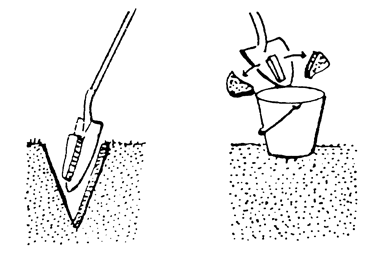Soil Sampling Method For Soil Testing
- Fertilizer is not only an indispensable input of modern agriculture but also a major contributor to increase crop production. Therefore over reliance on chemical fertilizers results not only in higher cost of production but several problems of environment (i.e. biodiversity decline, eutrophication, hypoxia, nitrate pollution, heavy metal pollution, acid rains, emission of green house gases etc.) and human health (i.e. methemoglobinemia, cancer, Minamata disease, Itai-itai disease etc.).
- To overcome these alarming problems there is urgent need for judicious use of chemical fertilizers which is possible through accurate fertilizer recommendation. While for accurate fertilizer recommendation and soil testing, accurate soil sampling is only the way out. Authentic representative soil sample is essential for soil testing to save time and money, monitoring the changes in soil nutrient status and estimation of nutrient need for profitable crop production.
- Therefore to take accurate soil sample, a proper methodology with clear objective, time, depth and tool should be followed.
- Sampling tool should be selected according to soil condition (i.e. tube auger, spade, khurpi for soft and moist soil, screw auger for hard or dry soil and post hole bucket type auger for excessively wet areas/rice fields).
- Ideal sampling tool should be able to take small and equal volume of soil, easy to use and clean, adaptable to dry, sandy, moist and wet soils but also resistant to rust, bent and breakage.
- Sampling tool should be clean with non phosphate detergent and clean water to remove all visible particulate matter, residual oil, grease and soap residues etc. Finally tool should be rinsed with distilled water and if possible wipe the tool dry with towel, paper or clean cloth.
- Sampling site should be cleaned properly by scraping the litter and plant parts from the soil surface. Sampling field should be traversed in to homogeneous units of uniform area (0.5 Ha) based on decree of erosion, soil type, variation in slope, soil colour, soil texture, crop growth, cropping history, management practices and other factors affecting the nutrient status in soil.
- Sampling should be avoided from unusual areas (i.e. recently fertilized plots, manure piles, eroded knolls, low spots, marshy tracts, areas near bunds, channels, trees, wells, fences, roads, compost pits and other non representative locations). Sampling should be done separately if distinct area is large enough.
- Generally samples are collected with the help of khurpi and spade. Sample digging should be done in such a way that ‘V’ shaped hole is made and cut out an uniformly thick slice (2.5 cm) of soil from bottom to top of the exposed surface.

- Random collection of soil sample from each uniform unit at desired depth from 5-10 spots separately in a field is known as primary sample.
- Sample may be collected at any time within a year. Sampling should be done in autumn after the harvest of kharif crops or 2-4 weeks before crop planting. Sample may be collected from the previous standing crop also.
- Sampling frequency should also be considered (i.e. sample each year for analysis of mobile nutrients and areas where intensive cultivation is followed but for general purpose sample once in three year).
- Primary samples should be collected according to the size of area (i.e. 2 ha, 2-10 ha, 10-20 ha and >20 ha with 15, 25, 35 and 45 number of samples respectively).
- Sampling depth should be decided according to soil condition and crop cultivation (i.e. sample should be taken at 0-8 cm, 0-15 cm, 15-30 cm and at 15 cm interval up to 100 cm depth for grass land areas, shallow rooted seasonal crops, deep rooted longer duration crops and plantation crops respectively).
- Primary samples of a uniform area/unit should be collected in a bucket and mixed thoroughly.
- Composite sample size should be reduced by quartering method to attain desired amount (250-500 gm).
- Sample should be air dried in shade by spreading on plastic sheet.
- Sample should be cleaned by discarding plant residues, gravels, coarse concretions, stones and other debris/materials if present.
- Sample should be processed by crushing large soil clods with the help of wooden roller.
- Entire quantity of soil sample after grinding should be passed through 2 mm stainless steel sieve and discard the materials having more than 2 mm size.
- Processed soil sample should be stored in clean cloth or polythene bags. Glass and porcelain jar should be used for long duration storage.
- Sample should be labeled properly with identification mark and other details (i.e. name and address of bearer, location of the field, soil type, date of sampling etc.). After keeping one label inside another label carrying similar details should be tied outside the bag.
- Separate information sheet should also be sent with details (i.e. location, field No., identification mark, soil type, slope, drainage, irrigation, previous cropping history, fertilizers and manures used, sampling depth, number of spots sampled, area of the field and farmer’s name). Name of the crop should also be sent for which fertilizer recommendation is sought.
Precautions:
- Sampling should be done at the same time (month) in each year.
- Sample collected from unusual area should be kept separately with some identification marks.
- Special care should be taken with the soil sample to avoid contamination with chemicals, fertilizers and manures.
- Previously used bags for fertilizers and chemicals should not be used either for drying or storage of sample.
- Excessive grinding of soil sample should be avoided.
- Artificial heating to dry soil sample should also be avoided.
Therefore soil sampling with proper care and proper method reduces the cost of crop production resulting higher benefit. Because “as you sow so you reap”, hence soil sampling is the back bone of soil testing.
